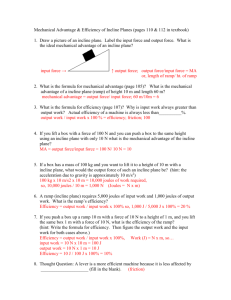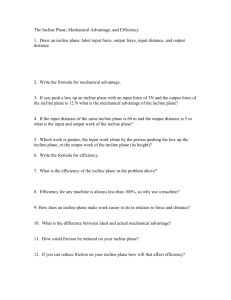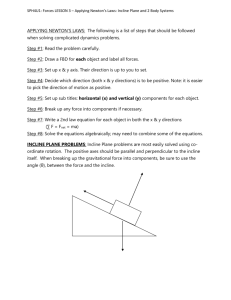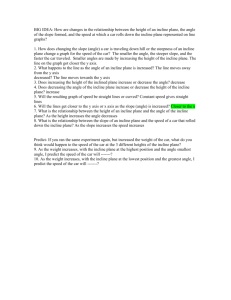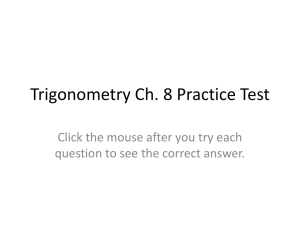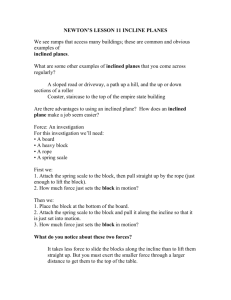Armaghan
advertisement
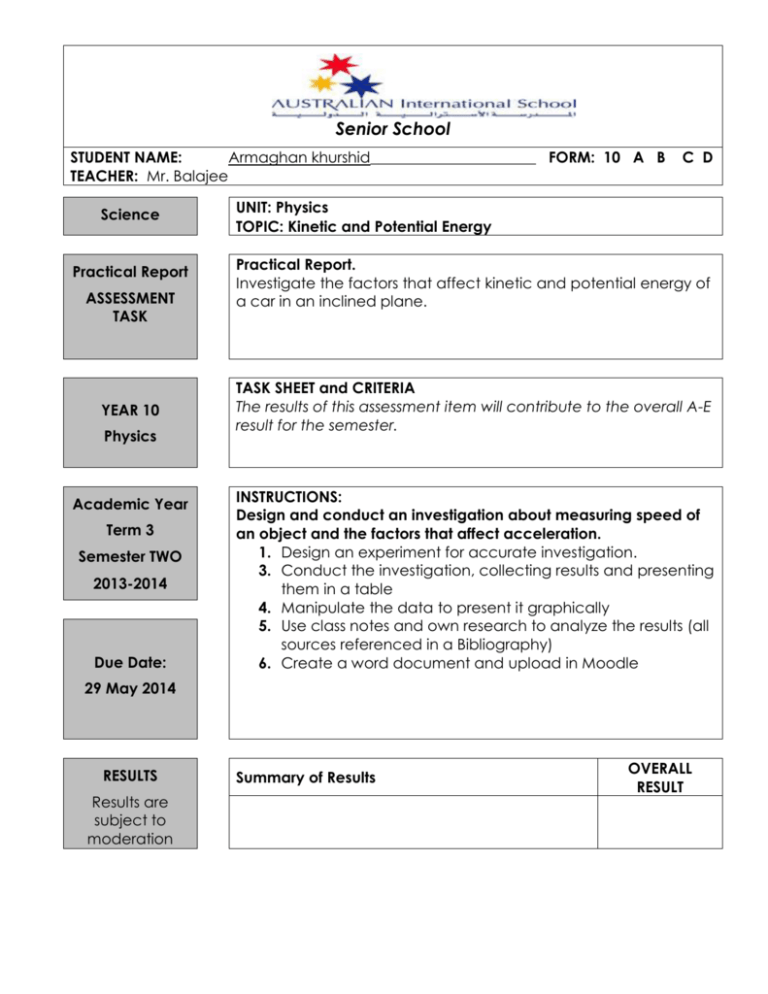
Senior School STUDENT NAME: Armaghan khurshid______________________ FORM: 10 A B TEACHER: Mr. Balajee Science Practical Report ASSESSMENT TASK YEAR 10 Physics Academic Year Term 3 Semester TWO 2013-2014 Due Date: C D UNIT: Physics TOPIC: Kinetic and Potential Energy Practical Report. Investigate the factors that affect kinetic and potential energy of a car in an inclined plane. TASK SHEET and CRITERIA The results of this assessment item will contribute to the overall A-E result for the semester. INSTRUCTIONS: Design and conduct an investigation about measuring speed of an object and the factors that affect acceleration. 1. Design an experiment for accurate investigation. 3. Conduct the investigation, collecting results and presenting them in a table 4. Manipulate the data to present it graphically 5. Use class notes and own research to analyze the results (all sources referenced in a Bibliography) 6. Create a word document and upload in Moodle 29 May 2014 RESULTS Results are subject to moderation Summary of Results OVERALL RESULT Year 10 Learning Area Standard Descriptor: Science Skills Understanding A B The students work has the following characteristics: Comprehensive description and explanation of scientific information about photosynthesis and respiration, their concepts and relationships Use of science knowledge to generate solutions and reasoned explanations about a range of examples, including some that are complex and unfamiliar Systematic examination of social and technological factors that influence the development of science knowledge and the effect of science on people’s lives Reasoned analysis of the development and review of scientific models and theories; and the use of scientific knowledge to test claims, explanations or predictions Formulation of questions and hypotheses that can be investigated scientifically, explicitly linked to science knowledge Concise description of methods designed to control and accurately measure variables and systematically collect data, considering safety, reliability and ethical actions Comprehensive analysis of trends in data to explain relationships between variables and to develop justified conclusions C D Significant description and explanation of scientific information about photosynthesis and respiration, their concepts and relationships Use of science knowledge to generate solutions and informed explanations about examples, including some that are complex familiar situations Description and identification of scientific information about photosynthesis and respiration, their concepts Statements of scientific information about photosynthesis and respiration and related scientific knowledge Use of science knowledge to generate solutions and explanations about examples, including some that are simple familiar situations Use of science knowledge to generate partial solutions and explanations Examination of social and technological factors that influence the development of science knowledge and the effect of science on people’s lives Description of social and technological factors that influence the development of science knowledge and the effect of science on people’s lives Statements about factors that influence science and its effects Analysis of the development and review of scientific models and theories; and the use of scientific knowledge to test claims, explanations or predictions Descriptions of the development and review of scientific models and theories; and the use of scientific knowledge to test claims, explanations or predictions Statements about scientific models and how science is used to test claims Formulation of questions and hypotheses that can be investigated scientifically, informed by science knowledge Formulation of questions and hypotheses that can be investigated scientifically Statements of questions and hypotheses Description of methods designed to control and accurately measure variables and systematically collect data, considering safety, reliability and ethical actions Description of methods designed to control and measure variables and collect data, considering safety, reliability and ethical actions Description of methods used to safely collect data in given investigations Significant analysis of trends in data to describe relationships between variables and to develop supported conclusions Analysis of trends in data to identify relationships between variables and to develop conclusions Description of trends in data and statements of conclusions E Statements of isolated scientific facts Statements about the use of science Safe, directed use of equipment in given investigations Listing of data and superficial statements of conclusion Use of science knowledge to systematically evaluate the claims and methodologies in secondary sources Evaluation of methods, explanations and accurate identification of sources of uncertainty and reasoned proposals of modifications to improve the quality of evidence Clear and purposeful use of appropriate scientific language and representations to concisely communicate findings and ideas to specific audiences Use of science knowledge to evaluate the claims and methodologies in secondary sources Analysis of methods, accurate identification of sources of uncertainty and specific proposals of modifications to improve the quality of evidence Purposeful use of appropriate scientific language and representations to concisely communicate findings and ideas to specific audiences Use of science knowledge to examine the claims and methodologies in secondary sources Evaluation of methods, explanations and accurate identification of sources of uncertainty and reasoned proposals of modifications to improve the quality of evidence Clear and purposeful use of appropriate scientific language and representations to concisely communicate findings and ideas to specific audiences Statements of science knowledge relating to claims in secondary sources Superficial statements about secondary sources Analysis of methods to propose simple improvements Superficial statements of improvements to methods Use of aspects of scientific language and representations to communicate findings and ideas Use of everyday language to communicate findings and ideas Yr. 10 Science Practical Report Writing Remember: Use Headings For all diagrams, tables and graphs: Use pencil and label it Give a Figure number to all diagrams & Tables 1. Title Page Include: relevant name of Practical Activity; Your name, Teacher name 2. 3. 4. Contents Page Aim A few sentences to describe: what the practical activity is about and why it needs to be completed. Hypothesis and Variables List the Independent, Dependent and controlled variables. Hypothesis: Use third person, one or two sentences that describe what the results might show. The relationship between the independent and dependent variables should be described. 5. Method A step-by-step list of instructions written in past tense. They must be detailed enough so anyone could follow them and if they did, they would end up doing exactly the same things that you did. 6. Safety Precautions Write in third person. Explain how to prevent injury to people, damage to the equipment being used, and explain why they are necessary. 7. Results Display your results in table(s).The independent variable is listed down the first column of the results table. Make sure you include the appropriate units in the title of each column (if necessary). Graphs: Give each graph a Figure number and an appropriate title. Label the axes (including relevant units). 8. Evaluation Write in third person. Describe what patterns/relationships are shown in the results. Explain what the patterns/relationships mean. Reflect on the method: was the method followed correctly? Were the results collected accurately? Was the investigation a fair test and was it reliable? Suggest some improvements that could be made if it was to be repeated practical activity? 9. Conclusion Review the aim and state whether the aim was achieved. Briefly summarise what the results were and what they mean. 10. Bibliography List your sources of information (websites, books, television shows, magazine article, newspaper article, etc.) Investigation of Energy, Time and Distance Armaghan Khurshid Teacher: Mr. Balajee Aim: o The aim of this experiment is to investigate, over 3 trials, the amount of time it takes a car to travel ‘x’ distance with ‘y’ energy using an inclined plane. The height, the mass and the amount of energy, stays constant throughout the whole experiment. Hypothesis and Variables: o Independent variable/s: Distance car travels o Dependent variable/s: Time o Controlled variable/s: Number Variable How it’s controlled? 1 Distance Distance is controlled by placing an object that is large and heavy enough to so stop the car at specific points. 2 Height The height is controlled by safely locking the incline plane to a constant height. 3 Mass No objects are added or removed from the car throughout the experiment, so the mass is also constant. 4 Energy Due to mass of the car and height of the incline plane being constant, energy also stays constant as the car is only released once it’s at a complete stop(stationary or 0m/s). o Hypothesis: The velocity of the car will stay the same throughout the experiment despite the changes in the distance (independent variable) at which it’s stopped but the time (dependent variable) will increase as the distance measured increases. Method: 1. 2. 3. 4. 5. Set the incline plane to a height of 30 cm. Lock the incline plane safely so it does not alter. After locking it in place, measure the height again. Place the incline plane on a flat surface. Leave a space of at least 10 cm between the plane and your 0 cm mark. –This gives you time to concentrate on starting your stopwatch at just the right time. 6. Measure 50 cm from your 0 cm mark. 7. Place a heavy object with large area at the 50 cm mark. – This will help stop the car and the stopwatch at the right moment again. 8. Place car at very top of the incline plane and let it go. –Make sure that you do not apply any unnecessary force while letting go of the car. 9. Do this for three times and record your results. –The time you got each time you carried this out. 10. Move the object to 100 cm mark and carry out steps 8 and 9 again. 11. Now move the object to 150 cm mark and carry out steps 8 and 9 again. 12. Record your results on a table and then to a graph. Safety Precautions: o Do not wave around the incline plane. –This action can critically injure someone if you hit them in the face or neck. o Do not play with the lock of the incline plane. –This can damage the equipment and make hazardous for regular use. o If lock is jammed, ask for help. –Do not experiment, as it will result in the damaging of the equipment. o Do not wave around the ruler. –This can also injure or bruise someone’s body. o Watch both ends of the ruler while changing directions and keep it clear of eyes. – Hitting someone in there is not only torturous but also can result in loss of vision. o Do the blockade object is too heavy, do not try to lift it. –If dropped on your foot, it can crush the toes. o Keep clear of the person holding the blockade object. –This is to make sure that no injuries occur accidentally. o Don’t throw the car around the room. –Not only this damages the equipment, but also can injure someone while they are unaware of it. Results: Distance (centimeters) Time (seconds) Trial 1 Trial 2 Trial 3 Average 50 0.52 0.44 0.48 0.48 100 1.22 1.30 1.38 1.5 150 2.38 2.09 2.00 2.16 Trial 1: Trial 1 160 140 Distance (cm) 120 100 80 60 40 20 0 0 0.5 1 1.5 2 2.5 1.5 2 2.5 Time (s) Trial 2: Trial 2 160 140 Distance (m) 120 100 80 60 40 20 0 0 0.5 1 Time (s) Trial 3: Trial 3 160 140 Distance (cm) 120 100 80 60 40 20 0 0 0.5 1 1.5 2 2.5 Time (s) Average: AVERAGE 160 140 Distance (m) 120 100 80 60 40 20 0 0 0.5 1 1.5 2 2.5 Time (s) Evaluation: o The results show that as the distance measured and time increase if the velocity is fairly constant or decreased. There’s another pattern which shows that the velocity of the car is fairly constant but not exactly the same until 1.5 seconds. After 1.5 seconds, the cause of friction can clearly be seen. This means that due to friction, the car slows down and comes to a complete stop or else, it could go on forever. This also means that energy is reduced due to friction. The method was followed precisely and having three trails will help the investigator realize and pick up a mistake if it would’ve occurred. If the test was to be carried out again, collecting more results (e.g. go further than 50 increments, 25 then 50 then 75, then 100, etc.) to help pick up more trends or patterns that may not have yet been detected. Conclusion: o The aim was to investigate the activity of time and yes, the aim was achieved. The results represented that the time to cover a large distance at same amount of energy applied, would shift dramatically. The results also represent the effect of friction and how the object loses its velocity or energy over time.
